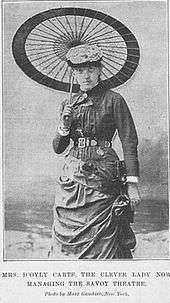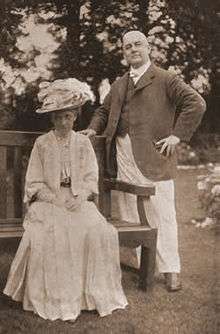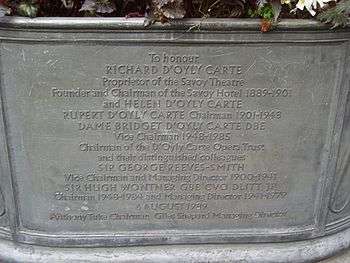Helen Carte

Helen Carte Boulter (born Susan Helen Couper Black; 12 May 1852 – 5 May 1913), also known as Helen Lenoir, was the second wife of impresario and hotelier Richard D'Oyly Carte. She is best known for her stewardship of the D'Oyly Carte Opera Company and Savoy Hotel from the end of the 19th century and into the early 20th century.
Born in Wigtown, Scotland, she attended the University of London from 1871–74 and pursued brief teaching and acting careers. In 1875, she met Richard D'Oyly Carte and soon became his assistant and business manager. She helped produce all of the Gilbert and Sullivan and other Savoy Operas, beginning with The Sorcerer in 1877 and for the rest of her life, and helped Carte with all of his business interests. One of her principal assignments was to superintend arrangements for American productions and tours of the Gilbert and Sullivan operas. Her grasp of detail and her diplomatic skills surpassed even those of her husband.
She married Richard D'Oyly Carte in 1888. During the 1890s, with her husband's health declining, Helen assumed greater and greater responsibility for the businesses, taking full control upon his death in 1901. She remarried in 1902 but continued to own the opera company and run most of the Carte business interests until her death, when they passed to her stepson, Rupert D'Oyly Carte. Although the D'Oyly Carte Opera Company's operations decreased after Richard's death, Helen staged successful repertory seasons in London from 1906 to 1908, establishing that the Gilbert and Sullivan operas could continue to be revived profitably.
By the time of her death in 1913, the opera company had become a repertory touring company, and W. S. Gilbert had died. Helen hired J. M. Gordon to preserve the company's unique style. In her will, she left the Savoy Theatre, the Savoy Hotel and the opera company to Rupert, the last of which operated continuously until 1982.
Life and career

Early years
Susan Helen Couper Black (or Cowper Black in some sources)[1] was born in Wigtown, Scotland, to George Couper Black (1820–c. 1874), procurator fiscal and banker, and his wife, Ellen, née Barham (1823–after 1877 from Penzance), the second of four siblings. One of her brothers, John McConnell Black, later became a well-known botanist. Her grandfather, Robert Couper, M.D., was a Scottish physician and poet.[2]
She attended the University of London from 1871–74 and was a gifted student, passing the examinations for Special Certificates in mathematics and in logic and moral philosophy (the university did not award degrees to women until 1878). She also spoke several languages. She registered at the university as Helen Susan Black. After her studies, she taught mathematics and had a brief acting career, during which she changed her name to Helen Lenoir ("Black", in French).[3] She appeared at the Gaiety Theatre in Glasgow, Scotland, in The Great Divorce Case. While a member of the Theatre Royal, in Dublin, Ireland in September 1875, Helen met Richard D'Oyly Carte. He was there to manage the first tour of Trial by Jury, and Helen became fascinated by his vision for establishing a company to promote English comic opera.[4] She gave up her next engagement to join his theatrical organisation.[5]
In 1877, Helen's mother, then a widow, relocated with Helen's sister and two brothers to Australia. Helen had just become secretary to Richard D'Oyly Carte and remained in London to help with production of The Sorcerer at the Opera Comique.
The woman behind the man
From the time that she was hired as Carte's secretary, Helen was intensely involved in his business affairs and had a grasp of detail and organisational and diplomacy skills that surpassed even Carte's.[6] She became the business manager of the company and was also responsible for the Savoy Hotel, into which she introduced the new hydraulic passenger lifts. One of Helen's early tasks was to produce the British copyright performance of The Pirates of Penzance in Paignton. She made fifteen visits to America to promote Carte's interests, superintending arrangements for American productions and tours of the Gilbert and Sullivan operas. She also assisted in arranging American lecture tours for Oscar Wilde, Matthew Arnold and others. Helen, more than anyone else, was able to smooth out the differences between W. S. Gilbert and Arthur Sullivan, in the 1880s, to ensure that the two produced more operas together.[7] She also tactfully and sympathetically dealt with the personal and professional problems of the actors in the D'Oyly Carte Opera Company casts. The editor of The Era wrote in her obituary, "She never took advantage of anybody; but I never heard of her letting anybody take advantage of her."[5]

In 1886, Carte raised Helen's salary to £1,000 a year plus a 10% commission on the net profits of all business at his theatres. According to historian Jane Stedman, "When she demurred, he wrote, 'You know very well, and so do all those who know anything about my affairs, that I could not have done the business at all, at any rate on nothing like the same scale, without you'".[5] Carte's first wife had died in 1885, and Helen married Richard on 12 April 1888 in the Savoy Chapel, with Sir Arthur Sullivan acting as Carte's best man.[8]
The couple's London home included the first private elevator. James McNeill Whistler, a client of Carte's agency and friend of the Cartes, made an etching of Helen in 1887 or 1888, "Miss Lenoir", and later helped to decorate the Cartes' home. Although some sources refer to Mrs. Carte as "Helen D'Oyly Carte", this is incorrect, as D'Oyly was a given name, not a surname. Her married name was Helen Carte. Throughout the 1890s, Richard's health was declining, and Helen assumed more and more of the responsibilities for the opera company and other family businesses. In his 1922 memoir, Henry Lytton described Helen Carte as follows:
- "She was a born business woman with an outstanding gift for organisation. No financial statement was too intricate for her, and no contract too abstruse. Once, when I had to put one of her letters to me before my legal adviser... he declared firmly 'this letter must have been written by a solicitor.' He would not admit that any woman could draw up a document so cleverly guarded with qualifications. Mrs. Carte, besides her natural business talent, had fine artistic taste and was a sound judge, too, of the capabilities of those who came to the theatre in search of engagements".[9]
In 1894, Carte hired his son Rupert D'Oyly Carte as an assistant. Rupert's older brother, Lucas (1872–1907), a barrister, was not involved in the family businesses and died of tuberculosis at the age of 34.[10] With no new Gilbert and Sullivan shows written after 1896, the Savoy Theatre put on a number of other shows for comparatively short runs, including several of Sullivan's less successful operas. Young Rupert assisted Helen and W. S. Gilbert with the first revival of The Yeomen of the Guard at the Savoy in May 1897.[11] In 1899, the theatre finally had a new success in Sullivan and Basil Hood's The Rose of Persia.[12]
After Carte's death

Richard died in 1901 leaving the theatre, opera company and hotel to Helen, who assumed full control of the family businesses.[13] She leased the Savoy Theatre to William Greet in 1901. She oversaw his management of the D'Oyly Carte Opera Company's revival at the Savoy of Iolanthe, and several new comic operas including The Emerald Isle (1901; Sullivan and Edward German, with a libretto by Basil Hood), Merrie England (1902) and A Princess of Kensington (1903; both by German and Hood).[5]
The last of these ran for four months in early 1903 and then toured. When A Princess closed at the Savoy, Greet terminated his lease,[14] and Helen leased the theatre to other managements until 8 December 1906. She had married Stanley Carr Boulter, a barrister, in 1902, but she continued to use the surname Carte in her business dealings. Boulter assisted her in the Savoy businesses. She was a founder member of the Society of West End Theatre Managers, along with Frank Curzon, George Edwardes, Arthur Bourchier and sixteen others.[15]
Her stepson Rupert took over his late father's role as Chairman of the Savoy Hotel in 1903, which Helen continued to own. The years between 1901 and 1906 saw a decline in the fortunes of the opera company. The number of D'Oyly Carte repertory companies touring the provinces gradually declined until there was only one left, visiting often small centres of population. After the company visited South Africa in 1905, more than half a year elapsed with no professional productions of G&S in the British Isles. During this period, Helen and Rupert focused their attention on the hotel side of the family interests, which were very profitable.[5]
In late 1906, Helen re-acquired the performing rights to the Gilbert and Sullivan operas from Gilbert (she already had those of Sullivan) and staged a repertory season at the Savoy Theatre, reviving the opera company and leasing the Savoy to herself. She persuaded the recently knighted Gilbert, now 71, to stage direct the productions in repertory, and once again she had to exercise the greatest tact, as Gilbert sometimes had difficulty accepting that he was no longer an equal partner and was taking no financial risk. Gilbert was angry that he had not been consulted regarding casting of the productions.[16] The season, and the following one, were tremendous successes, revitalising the company. Contemporary accounts describe her taking three curtain calls with Gilbert on the opening night of the 1906 revival of The Yeomen of the Guard.[5]

After the repertory seasons in 1906–08, however, the company did not perform in London again until 1919, only touring throughout Britain during that time. Carte wrote in 1911 that her health made it impossible for her to produce any more revivals at the Savoy.[16] In March 1909, Charles H. Workman assumed management of the Savoy Theatre from the now frail Helen Carte Boulter. However, she continued to manage the rest of the family businesses with the assistance of Rupert. In 1911, the company hired J. M. Gordon, who had been a member of the company under Gilbert's direction, as stage manager. Carte was also so generous that King George V granted to her the Order of the League of Mercy in 1912.[5]
After another illness lasting several months, Helen died of a cerebral haemorrhage complicated by acute bronchitis in 1913, a week before her 61st birthday. A private funeral was held at Golders Green crematorium. In her will, she left the Savoy Theatre, the opera company and the Savoy Hotel to Rupert, bequests of £5,000 to each of her two brothers and smaller bequests to a number of friends and colleagues. She left the considerable residuary estate to her husband.[17] The D'Oyly Carte Opera Company continued to operate continuously until 1982.[18]
Portrayals in film and television
Carte has been portrayed in the films The Story of Gilbert and Sullivan (1953) by Eileen Herlie[19] and in Topsy-Turvy (1999) by Wendy Nottingham.[20] She was also portrayed in the British 1961 3-part TV series, Gilbert & Sullivan: The Immortal Jesters.
Notes
- ↑ Cellier and Bridgeman, p. 379
- ↑ Seeley, p. 17
- ↑ Seeley, p. 18
- ↑ Ainger, p. 111
- 1 2 3 4 5 6 7 Stedman, Jane W. "Carte, Helen (1852–1913)", Oxford Dictionary of National Biography, Oxford University Press, September 2004, doi:10.1093/ref:odnb/59169; accessed 12 September 2008
- ↑ Ainger, pp. 111–12
- ↑ Jacobs, Arthur. "Carte, Richard D'Oyly (1844–1901)", Oxford Dictionary of National Biography, Oxford University Press, September 2004, accessed 12 September 2008, doi:10.1093/ref:odnb/32311
- ↑ Goodman, Andrew. Gilbert and Sullivan's London (1988; 2000), Faber & Faber; ISBN 0-571-20016-8
- ↑ Lytton, Henry. Secrets of a Savoyard (1922), chapter 4
- ↑ Obituary of Lucas D'Oyly Carte, The Times, 22 January 1907, p. 12
- ↑ New York Post, 7 January 1948
- ↑ Wearing, p. 844; and Gordon-Powell, Robin. Notes to programme for Sir Arthur Sullivan Society Festival Concert, 16 September 2006, London
- ↑ Joseph, p. 133
- ↑ The Penny Illustrated Paper and Illustrated Times, 11 July 1903
- ↑ "The Society of West-End Theatre Managers", The Times, 24 April 1908, pg. 17.
- 1 2 Carte, Bridget D'Oyly. Foreword to Mander, Raymond and Joe Mitchenson, A Picture History of Gilbert and Sullivan, Vista Books, London, 1962.
- ↑ The Times, 6 May 1913, p. 11, reporting on "Probated Will of Helen Boulter"
- ↑ Skow, John. "Final Curtain for D'Oyly Carte", Time magazine, 8 March 1982.
- ↑ Shepherd, Marc. The Story of Gilbert and Sullivan, Gilbert and Sullivan Discography, 21 October 2001, accessed 5 January 2016
- ↑ Shepherd, Marc. "Topsy-Turvy (1999)", Gilbert and Sullivan Discography, 6 March 2009, accessed 5 January 2016
References
- Ainger, Michael (2002). Gilbert and Sullivan – A Dual Biography. Oxford: Oxford University Press. ISBN 0-19-514769-3.
- Joseph, Tony (1994). D'Oyly Carte Opera Company, 1875–1982: An Unofficial History. London: Bunthorne Books. ISBN 0-9507992-1-1
- Seeley, Paul. "Who Was Helen Lenoir?", The Savoyard, September 1982 – Vol XXI No. 2
- Wearing, J.P. The London Stage 1890-1899: A Calendar of Plays and Players, Vol 2: 1897-1899, The Scarecrow Press (1976) ISBN 0-8108-0910-9
Further reading
- Cellier, François; Cunningham Bridgeman (1914). Gilbert and Sullivan and Their Operas. Boston: Little, Brown and Company.
- Fitz-Gerald, S. J. Adair (1924). The Story of the Savoy Opera. London: Stanley Paul & Co.
- Hibbert, Christopher (1976). Gilbert & Sullivan and Their Victorian World. New York: American Heritage Publishing Co., Inc.
- Jones, Brian. "Patrick W. Halton", W. S. Gilbert Society Journal, vol. 1 (1993), pp. 208–20
- Prestige, Colin. "Ourselves and the operas", Gilbert and Sullivan Journal, vol. 8 (May 1963), p. 159
- Wilson, Robin; Frederic Lloyd (1984). Gilbert & Sullivan – The Official D'Oyly Carte Picture History. New York: Alfred A. Knopf, Inc.
- Daily Mail obituary, 6 May 1913
- Evening News obituary, 6 May 1913
- The Star obituary, 6 May 1913
- The Times obituary, 6 May 1913
- Westminster Gazette obituary, 6 May 1913
- The Era obituary, 10 May 1913
External links
- Information from the Lyric Opera of San Diego
- Description of Mrs. Carte's production of the Paignton performance of Pirates